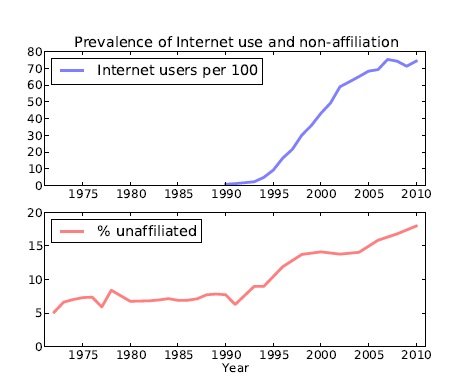Last updated on April 13, 2014
From the very serious MIT Technology Review:
Back in 1990, about 8 percent of the U.S. population had no religious preference. By 2010, this percentage had more than doubled to 18 percent. That’s a difference of about 25 million people, all of whom have somehow lost their religion.
That raises an obvious question: how come? Why are Americans losing their faith?
Today, we get a possible answer thanks to the work of Allen Downey, a computer scientist at the Olin College of Engineering in Massachusetts, who has analyzed the data in detail. He says that the demise is the result of several factors but the most controversial of these is the rise of the Internet. He concludes that the increase in Internet use in the last two decades has caused a significant drop in religious affiliation.
The emphasis is mine. You can read the whole article — titillatingly titled “How the Internet Is Taking Away America’s Religion” — here. Oh, and here’s some “evidence” for you:
But wait! There’s more:
At this point, it’s worth spending a little time talking about the nature of these conclusions. What Downey has found is correlations and any statistician will tell you that correlations do not imply causation. If A is correlated with B, there can be several possible explanations. A might cause B, B might cause A, or some other factor might cause both A and B.
But that does not mean that it is impossible to draw conclusions from correlations, only that they must be properly guarded. “Correlation does provide evidence in favor of causation, especially when we can eliminate alternative explanations or have reason to believe that they are less likely,” says Downey.
Actually, and as many a member of the MIT Economics Department could have told the journalist who wrote that piece (remember: this was published in the MIT Technology Review), the problem with eliminating alternative explanations is that our imagination for alternative explanations is surprisingly limited, as are the data required to test those myriad alternative explanations. And were the data even first-differenced? I would think there is a unit root in both the dependent variable and the variable of interest, but what do I know?
I guess now is also the right moment to point out that the era of the Antichrist might have come, given that the Antichrist will be known by the number 666, that the sixth letter of the Hebrew alphabet is the letter ו (i.e., waw), which is equivalent to our “w” and so: 666= ווו = www? I mean, while we’re on the topic of the unlikely…
(ht: Gabriel Power.)
